THESIS COLLOQUIUM 2: Abstracts and Guest Critics PART TWO
Dec 10, 2022
Thesis students at the Azrieli School of Architecture & Urbanism presented in-progress work covering a broad range of topics, approaches, and themes at Colloquium 2, which took place from December 8 to 9 at the Architecture Building.
“The parameters for what constitutes an architecture thesis are wide, varying in
format, content, and method,” says Associate Professor Lisa Moffitt, chair of the Master of Architecture program. “This breadth of possibility is one thing that makes the thesis experience remarkable.”
Scroll down to see abstracts and images.
During the colloquium, students presented their thesis projects, questions, and positions to fellow students, faculty, and five external guest critics. See profiles below. Students received supportive feedback on how to propel their work forward through the next semester.
Carleton University’s Master of Architecture thesis culminates the MArch degree and takes place over a full academic year. Milestones include three colloquia.
Guest Critics
Brigitte Desrochers is a member of the Research and Innovation team at Infrastructure Canada. Past professional roles include serving as Architecture Officer at the Canada Council for the Arts, where she administered the Governor General Awards in Architecture, Canada’s presence at the Venice Biennale in Architecture, and the Prix de Rome in Architecture.
She also worked in the Urban Architecture and Public Places section of the Department of Urbanism at the City of Montreal, where she contributed to the planning of the Rue de la Commune, Champs de Mars, Lachine Canal, Faubourg Saint-Laurent, and Cité Internationale district.
After graduating from the school of architecture at Université de Montréal, Desrochers completed a master’s degree and a doctorate at the Harvard Graduate School of Design. Postdoctoral research projects brought her to the British School at Rome, the Federal University of Rio de Janeiro, the Study Centre at the Canadian Centre for Architecture, and the National Gallery of Canada. Her work in photography, theory, and history has been exhibited and published in more than 30 venues, including the Municipal Art Society of New York and Architettura Arte Moderna Gallery in Rome.
Ipek Türeli is an associate professor of architecture and Canada Research Chair in Architectures of Spatial Justice at McGill University. Her research engages with spatial justice, urban media, and visual culture, and her books include Orienting Istanbul (co-edited, 2010) and Istanbul Open City (2018). Previously, she was an Andrew Mellon Postdoctoral Fellow at Brown University and an Aga Khan Postdoctoral Fellow at MIT.
Türeli received a PhD in Architecture from the University of California, Berkeley, a BArch (Mimar) from Istanbul Technical University, and the AA Diploma from the Architectural Association School of Architecture in London. Her work has been published in Traditional Dwellings and Settlements Review, History of Photography, European Journal of Turkish Studies, International Journal of Islamic Architecture, and Global Discourse.
A current book project explores early American campus landscapes and race outside the Americas. Her work has received support from the Graham Foundation, Middle East Research Grant, SSHRC, FRQSC, and CFI. She serves on the board of directors of the Society of Architectural Historians and the advisory council of the International Association for the Study of Traditional Environments. She is also the book review editor for the Journal of the Society of Architectural Historians.
Professor Anne Bordeleau is the incoming director of the Azrieli School of Architecture & Urbanism starting January 1, 2023. She joins the Azrieli School after 15 years at the school of architecture at the University of Waterloo Architecture, where she also served as O’Donovan Director since 2016.
Bordeleau is an architectural scholar and educator with a longstanding interest in many “invisible” facets of architecture, whether time, social interactions, voices that might have been silenced, a building’s past, or what lies in the shadow of a city’s monuments. Her publications include articles in the Journal of Architecture, Architectural Theory Review, Architectural History, Architecture MPS, Footprint, and Les Cahiers de Droit. In addition, she has written chapters in books, Materiality and Architecture, Chora 7, Architecture’s Appeal), and a monograph, Charles Robert Cockerell, Architect in Time: Reflections around Anachronistic Drawings.
Bordeleau co-authored the book and exhibition and oversaw the creation of plaster casts for The Evidence Room, displayed at the 2016 Venice Biennale in Architecture, the Royal Ontario Museum, and the Hirshhorn Museum. She is interested in architecture as a cultural act, a commitment that informs her research as much as her approach to education.
Carole Lévesque is head of the School of Design at UQAM and co-founder of the Bureau d’études de pratiques indisciplinées, which is interested in critical design processes. She is also a research member of the Centre Cultures-Arts Sociétés (CELAT), an inter-university centre that aims to shed light on processes of pluralization. Through her research-creation work, she explores the forms of representation of the urban territory, its temporalities and its uses, particularly in the abandoned spaces of the city.
Lévesque is the author of About Uselessness in Architecture (2011) and Finding Room in Beirut, Places of the Everyday (2019). She co-edited the book Inventories, Documentation as a Design Project (2021) and is currently co-editing a book on the drawing and construction of imaginary places.
She recently co-curated, with Thomas-Bernard Kenniff, the exhibition Drawing Conversations at UQAM’s Design Centre, which brought together the work of 16 architects and academics in an exchange on contemporary drawing practices in architecture. It focused on the capacity of drawing to engage reflection on modes of representation, design practices, and research fields and the role of this reflection in the construction of a common world.
Body Territory:
Female urbanism in the Wellington Basin
Student: Chloé Lévesque
Advisor(s): Janine Debanne
The question of urban design for vulnerable populations has remained at the margins of urban planning and cities and neighbourhoods in Canada continue to be built according to dominant positions. The thesis considers the less visible members of a society, and more generally, persons who dwell on the margins and will explore the need for connectivity through safe and inclusive design strategies in Pointe Saint-Charles (Montreal). The thesis accepts a soon-to-be developed site on the Wellington basin as a starting point, and designs several “routes of connectivity” from established neighbourhoods to this stie, with a view to connecting it to the broader city, and thus, to nurturing access and inclusion in the new development.
Employing a poetic language of stems, the routes traverse adjacent neighbourhoods and touch down in significant locations including spaces of female memory like the nearby Five Flowers silos, before arriving at the Wellington basin development. By rooting the new development in the community, and by operating at the human-scale, these paths of remembrance reconcile women’s bodies with the territory. This thesis’ female-centered urbanism strategy celebrates women’s role in Montreal’s economic development and industrial history, while safeguarding women’s inclusion in the fabric of the city.
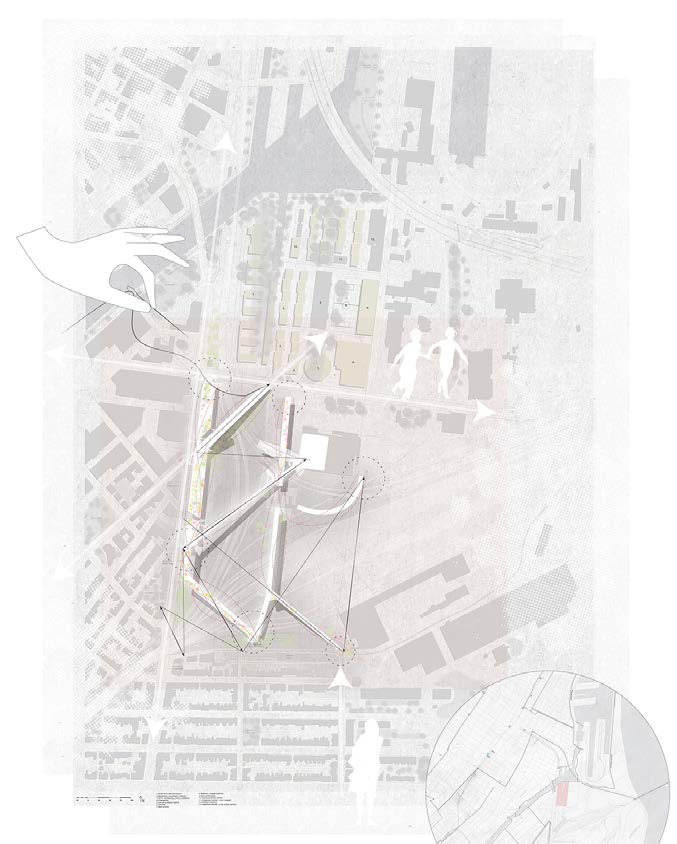
Cartography of Pointe Saint-Charles and the intent of connections
Bettering the Quality of Life for People with Dementia through Family and Community Cohousing
Student: Tavleen Mann
Advisor(s): Federica Goffi
Dementia is a cognitive disease that affects the way a person acts and thinks with symptoms affecting their memory, ability to think and other behavioural aspects. Over time, it progresses to a point where the person with dementia becomes dependent on others, usually their families, to perform normal daily tasks. The care can become too much to handle and a family may realize that the required level of care is more than what they can provide. Design work in the field of dementia care tends to focus on the design specific to institutional healthcare for the person with dementia, without considering the quality of life for this person in terms of sociability. This project is focused on researching dementia care through care home examples and other older adult living conditions to explore a model in which families can still live with a person with dementia while helping them get the quality care that they need. The goal is to create an innovative hybrid model between cohousing living conditions and dementia villages, in order to allow residents to have access to support but also as a way to be a part of a larger community that shares values and interests with other residents. By creating a living condition that houses people with dementia with their families, this project aspires to alleviate families’ guilt when realizing that their person with dementia needs more care than they can provide. In the end, we have a project that caters to not only people with dementia but their family members and caregivers as well.
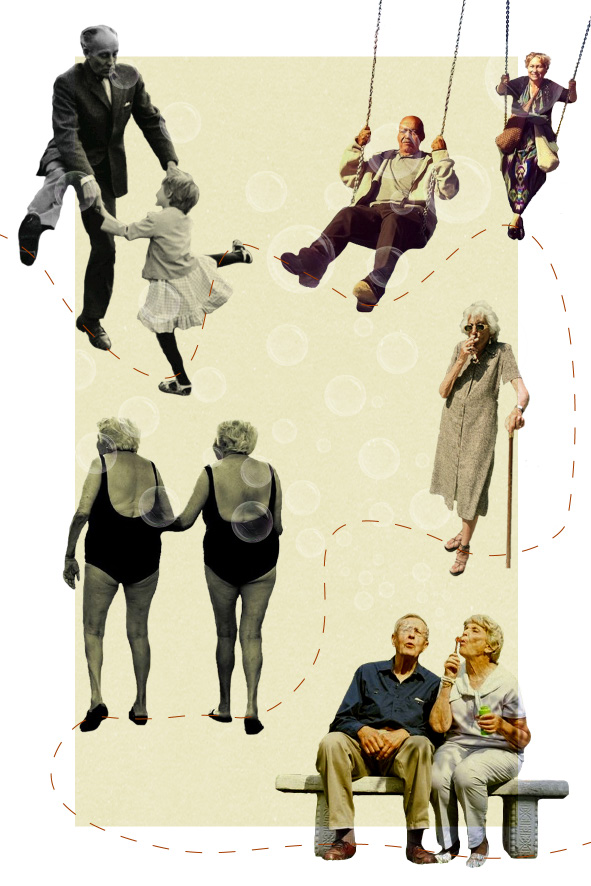
Older adults happily aging with the opportunity to continue doing what they enjoy most.
Still Motion:
Drawing Movement toward Adaptability in Time
Student: Dana Mastrangelo
Advisor(s): Federica Goffi
Within the built environment, buildings often behave as inanimate objects, unable to act and react to their occupants or surroundings. They are disjoined from time and remain motionless. These characterless characteristics are found in structures that idle as unresponsive and eventually decay due to their inability to evolve and adapt in time.
Since architecture can be described as the thoughtful making of space, it would theoretically appear trivial for architects to render buildings as independent from time and motion, as those are the very words used to define space. However, architectural drawings regularly illustrate static depictions of moments frozen in time, reducing the dimensional performance of space to a single, silent plane.
What would happen if architects actively represented motion within their drawings? My thesis aims to explore the following question: do buildings inherit adaptable qualities when they are drawn in time? In other words, would the layering of movement within architectural drawings require architects to consider a building’s active rapport with its users and environment? In responding to these questions, I will seek to study and discuss the notions of time, movement, and adaptability within the context of architecture and its representation, as well as the outcomes of adaptability when derived from traces of movement in architectural drawings.

Experimenting the representation of movement.
Re-Memory and Resistance:
Through Mapping and Making, An Imaginary Reconstruction of Blackness in Africville
Student: Otmar Melhado
Advisor(s): Menna Agha
Africville is a two and a half acre lot in Halifax, N.S, that is home to a northerly park and one of Canada’s oldest Black communities. It was a community that was razed for fifty years, starting in 1964 after administrators of the Halifax City Council decided to rezone the land for industrial use in 1947. Eventually, this seaside country village would be diminished after its original formation in 1848. Nevertheless, Africville refuses to die, it lives and reproduces itself in its people’s memories.
Through a counternarrative lens, the project explores forms of memory, re-memory, and resistance in making, as speculative social and traditional interventions in a wider context of black memorials and spaces across the Americas. Methodologically, this research engages with the state’s archives as well as the people’s archives, and intently prioritizes black histories which would position the project’s proposal towards reinterpreting the Afro-Canadian experience within a responsive and engaging historic and contemporary framework.
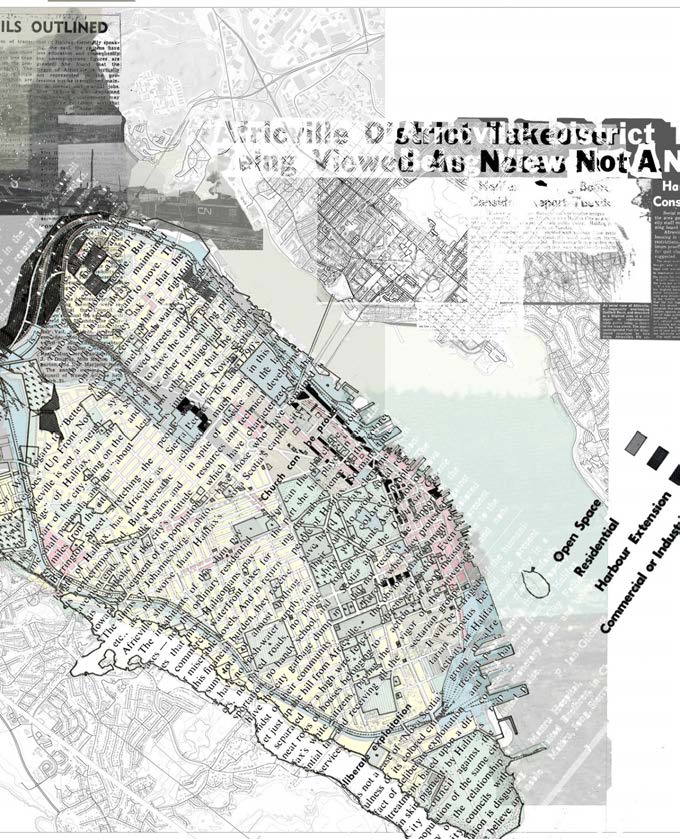
Collage of a tested industrial map and pro Africville council minutes texts overlaying the most current version of the Halifax city map as a means of testament to resisting the marginalizaion of lost black space
New Uses for Old Spaces:
A Case for Adapting Partially Vacant Office Buildings to Include Permanent Supportive Housing
Student: Alexandra Miller
Advisor(s): Ben Gianni
With working from home and hybrid models growing in popularity, many office spaces are partially or completely vacant. As a result, office buildings – especially those in need of life-cycle upgrades — are vulnerable to demolition. Such is the case for the Jeanne Mance Building, a 20-story office tower located on the federal government’s Tunney’s Pasture campus in Ottawa. Redevelopment plans for the site leave open the possibility that it, and several other towers in the government’s portfolio, be demolished to make way for housing and other uses.
At the same time, however, cities across North America are experiencing a rapid increase in the number of people experiencing homelessness, exacerbated by rising housing costs, inflation, the pandemic, and other factors. The City of Ottawa has proposed a 10-year plan to address the housing and homelessness crisis through the construction of permanent supportive housing. This, however, requires resources that are not readily available.
This thesis proposes tackling these issues together by exploring how all — or portions of — the Jeanne Mance building might be adapted to accommodate permanent supportive housing along with the support services that tenants might require. Given the deep floor plates of this and many other post-WWII office buildings, the most expedient solution might be to divide floors between office space and housing. Office rents can be used to subsidize the housing, which can take advantage of space for which there is diminishing demand. Using the Jeanne Mance Building as a case study for hybrid programs, the thesis hopes to develop an approach that can be applied to the transformation of other office buildings.
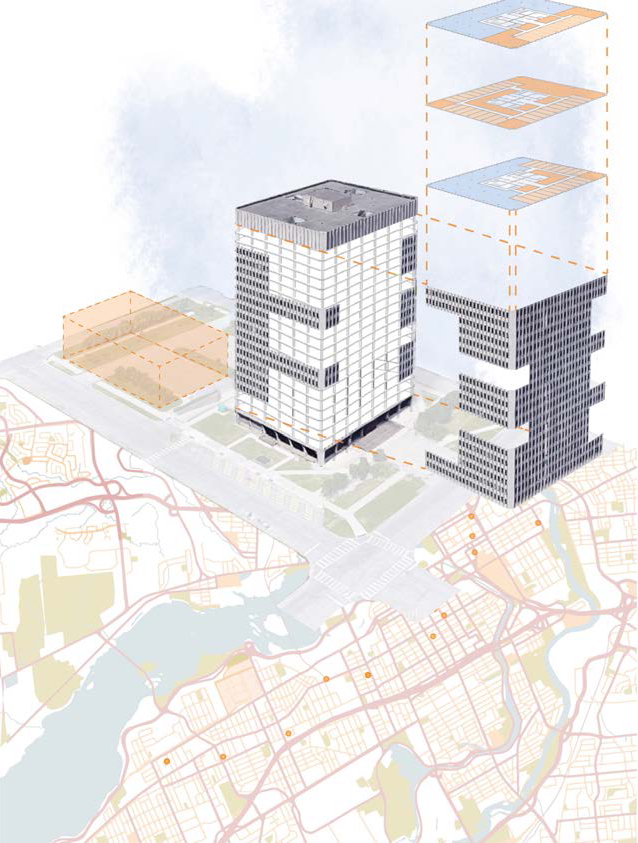
Collage of proposed intervention, hybrid plans and existing permanent supportive housing in Ottawa
Cebu’s Globalization:
The Space between Places
Student: Red Narvasa
Advisor(s): Stephen Fai
With a distinct blend of a Spanish and American past, alongside a Chinese predominance, the Philippines is very unique for its rich culture, traditions and delicate past. In Cebu, its oldest city and first capital, the economic disparity between social classes grew wider over time through its rapid economical and urban development. Although cultural development is somewhat necessary as tourism is an essential aspect for the economy, globalization will not cease to oppress heritage as it progresses.
One positive manifestation is the concept of asian night markets, which is argued to be either imported with the Chinese diaspora or as a unique South-East Asian tradition. This thesis aims to distill the architectural aspects needed to create the atmosphere of a night market. By studying elements that improve its experience, usability and functionality, the objective is to create a system more stable and resilient against the increasing marginalization of globalization.
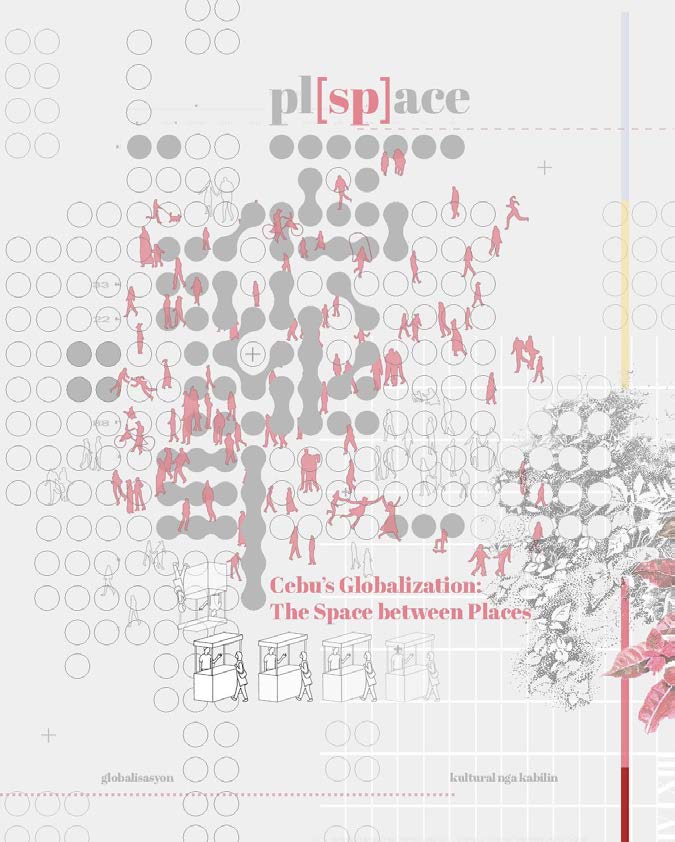
The interconnectedness between actants in a market
Architectures of Loneliness:
Designing for Social Connectedness in the Urban Built Environment
Student: Robert Oleksiak
Advisor(s): Jake Chakasim
The impact of the subjective feeling of loneliness and lack of meaningful social connection in our interpersonal relationships has escalated to epidemic levels. Research in cognitive science definitively shows loneliness’s negative impact to our psychological and physical health, indiscriminate of our age, race, or class, causing great stress on public health and our quality of life. In schools of architecture today, young architects are encouraged to find innovative solutions to societal problems such as the climate crisis or housing affordability, however, loneliness has not yet been elevated to the same level of crises within the context of architectural pedagogy.
This thesis aims to place loneliness on our agenda as architects. The primary research of this thesis, based on case studies, readings, and field research, will interrogate the relationship between the urban built environment and loneliness through the lens of three chosen demographic groups: the elderly, the working professional, and the graduate student. The accumulation of this research will be used to produce design guidelines for socially connected architecture to be later applied to the rehabilitation of existing spaces of loneliness.

Cosmovisions and Memories:
World-Building in the Age of Erasure
Student: Daniela Olivares
Advisor(s): Menna Agha
In an attempt to look deeper into my roots, I stumble on emptiness and voids. For all that I am can easily be defined as all that I am not. This disconnection is both a feeling and placement, so I embark on an exploration of Indigeneity and the self, through thoughts, memories, pointers, visions, and stories. I activate this research to claim and be claimed by my Pipil culture and reckon with the erasure faced within the nation-state of El Salvador. This thesis employs a move away from the dominant epistemology of the west for a re-working of centering and learning from Indigenous epistemologies.
This thesis explores how the spatial characteristics in Pipil Cosmovisions can define a new world-making by recentering realities transported down through generations. Through these cosmovisions, Pipiles build relationships with the environments, which in turn spill into the socio spatial fabric of contemporary El Salvador. Presencing Pipiles also explores in depth this induced disconnection from the end product: myself. As a grounded starting point, I explore autoethnography as a method. Cosmovisions are one of the many forms of Indigenous resistance and make way for a future re-composition of architecture that stems from Indigenous imaginaries.

Mapping of the self: Revealing the erased
Terrestrial Reef:
BioRock Futures for Toronto’s Failing Infrastructure
Student: Cameron Penney
Advisor(s): Lisa Moffitt
We live in a time where the human-made anthropomass exceeds the biomass on Earth. Toronto is one such urban anthropomass, under pressures related to rapid population growth and urban expansion. Toronto’s infrastructure, in particular, is coming to the end of its construction life, requiring costly maintenance and repair. Much of this infrastructure is not only vulnerable to failure but also acts as an ecological barrier to urban ecology. This thesis speculates on the role that BioRock can play in repairing Toronto’s crumbling land and water-based infrastructure, addressing biodiversity loss, reducing environmental pollutants, absorbing carbon, and creating socio-economic opportunities. BioRock is a grown-limestone, concrete alternative that has many positive benefits including its strength, its ability to foster ecological niches, and its capacity to act as a carbon sink. This thesis explores the potentials of BioRock through the technical domain, biological domain, and speculative domain. The thesis will develop a series of proposals for revitalizing three distinct infrastructural conditions in Toronto using physical experiments and infrastructural mappings.

Photo from Experiment 3 testing Mg/Na/Ca salts resulting in the first successful result of grown Aragonite BioRock. Photo by Author.
Disconnected Dubai:
A Tale of Two Cities
Student: Dalia Qasem
Advisor(s): Jerry Hacker
This thesis explores the long-standing systemic oppression of transient, low-income migrant workers in Dubai who have resorted to methods of self-actualized urbanism due to the city’s development. The thesis questions how the publicly presented face of Dubai – a city comprised of iconic architecture – sustains the inequities imposed on immigrant workers who are asked to uphold its affluent image? This is the tale of two cities, the duality of both ends of the socioeconomic spectrum translated into an urban disconnect. Despite this troubling context, migrant workers continue to find degrees of agency within Dubai as a catalyst for change. Through drawing, mapping, collages, and site visits the objective is to understand moments of exchange and resiliency among the migrant workers. The aim is to demonstrate that even in the face of extreme adversity and systemic oppression, architecture and urban planning can be used as a vehicle to provide low-income non-citizens agency and a voice by ensuring a better quality of life whilst simultaneously respecting site, context, and history.
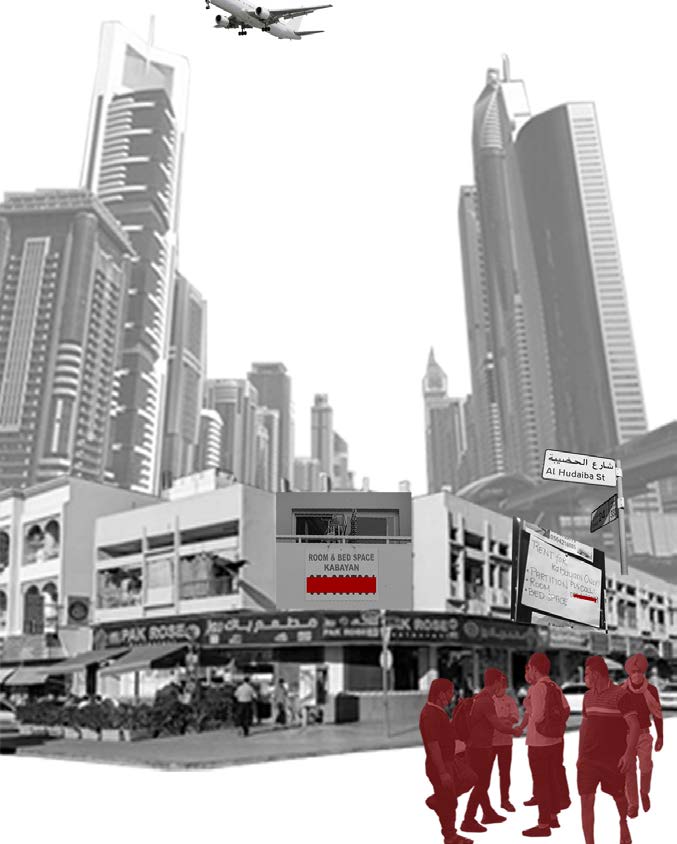
Data at Sea:
Reframing the Candian Coast Guard Archive
Student: Emma Rath
Advisor(s): Catherine Bonier
This Thesis explores the architectural issues that pertain to archival collecting practices within Canada. The Canadian Coast Guard has for many years been recording their voyages and missions on our three oceans. The CCG has created an archive that through the technology of photography documented decades of ice-breaking missions, building a paper archive that assumes these polaroid images and associated log sheets constitute determinate facts. This archive contains what is considered worthy of being remembered. This evidence then contributes to the establishment of the rules and protective boundaries that fix the Coast Guard’s evolving mandate.
How do we create more equitable and generously designed archival spaces, opening up old documents and stories to new consideration? Looking at specific central narratives, such as that of the Martha L. Black, an ice-breaking vessel operating in the 1980s, also allows a reimagination of archival possibilities. By looking at this ship’s active displacement and dislocation of ice to allow other ships passage through northern waterways, a visitor to a reconsidered, engaged archive might better understand the history of ice and of Canada. This thesis offers newfound pertinence to images and spreadsheets created to document the voyages of the Martha L. Black.
This thesis interrogates the role of photography in the Coast Guard’s documentation of their ice-breaking missions of the 1980s. New archive elements explore analogous methods of capturing and visualizing ice and water. During these arctic missions, the polaroid camera was used to capture snapshots of the impact of the ice breaking, a turbulent moment which resulted in images that are not exact representations but blurred, and further degraded in the decades since their creation.
These photos can still offer the basis for a new archive that invites the viewer into an intuitive understanding of ice and water, synthesizing the boundaries between scientific and abstract documentation. Through this new exploration and curation, this project offers both a critique of and a newfound appreciation for a forgotten archive.

Feminist City:
Reimagining Public Space that Rejects Sexual Violence
Student: Hilary Romaniuk
Advisor(s): Menna Agha
How can we confront existing urban public space which allows frequent sexual harassment and assault? Cities in the so called “developed” world have failed different varied bodies, notably, women+’s right to belong in public space, and our bodies are deprived of the comfortable relationship that is afforded to affluent, white, cis-gender men. This thesis aims to reimagine a public space that actively rejects sexual violence, and promotes equitably shared cities. This research employs a single case study methodology, looking closely at Dundonald park in Centretown Ottawa. To examine this case, I consult literature and global mapping initiatives that tackle issues of sexual harassment and women+’s safety in public spaces. This study aims to center the body by drawing from feminist mapping initiatives namely Body Mapping initiatives. Body mapping is a visual-arts-based therapeutic process which will be used during a communal session in the future to examine, share and visualise women+;s visceral experiences in the city. Ultimately, the mapping employed here aims to make women+s struggle visible, and seeks a better understanding of our positions, rights and possibilities in public space.
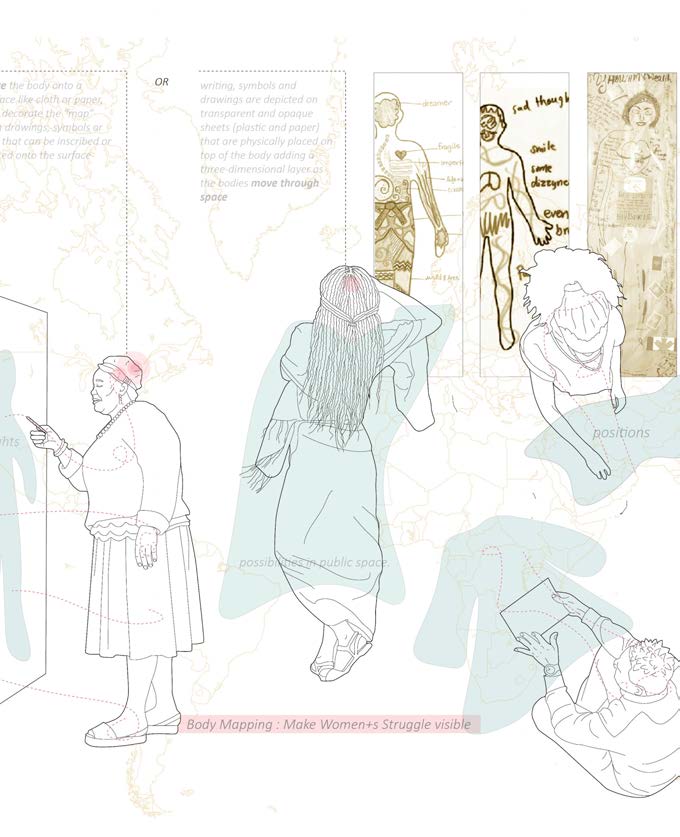
Student: Stephen Scanlan
Advisor(s): Benjamin Gianni
In my thesis, I intend to explore ways to associate ourselves in more meaningful ways with a non-human agency, specifically obsolete ‘objects,’ within a series of political and social injustices rendered through climate crisis. My methodology focuses on deconstructing materiality and phenomena of injustice on a deep time scale. In my thesis, I intend to explore ways to associate ourselves in more meaningful ways with a non-human agency, specifically obsolete ‘objects,’ within a series of political and social injustices rendered through climate crisis. My methodology focuses on deconstructing materiality and phenomena of injustice on a deep time scale.
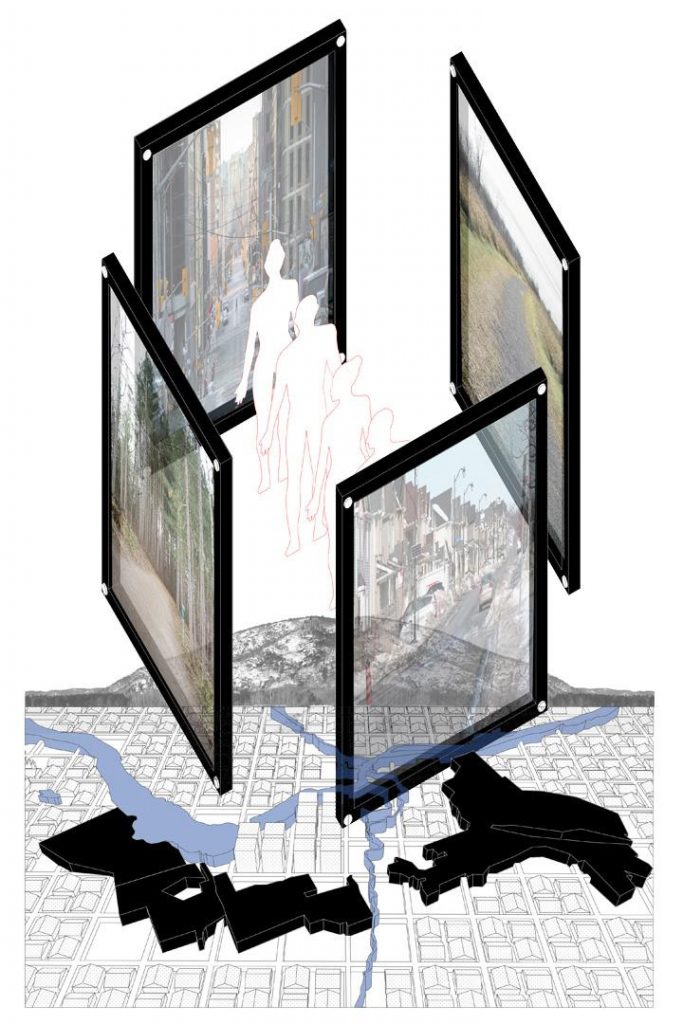
Memory in Ruin:
Re-establishing the Identity of Bosnia-Herzegovina Through the Restoration of Islamic Architecture
Student: Lejla Sejdinovic
Advisor(s): Piper Bernbaum
Between 1992-1995, the ethnic cleansing of the Muslim population within Bosnia and Herzegovina generated both physical devastation and human suffering not seen since World War II, with over 10% of the population killed or wounded, and over half displaced. The conflict arising due to tensions between the Serbian, Croatian, and Bosniak communities is remembered as cultural genocide, with widespread destruction of Ottoman and Islamic heritage done specifically to eradicate the presence of Muslims within the country. By 1993, Serbian forces had either damaged or destroyed nearly two-fifths of the total mosques in Bosnia. More than heritage however, was also a memory and cultural identity that was devastated. The intentions of my proposed thesis are to analyze the effects of the loss of this cultural identity, while also unraveling the development of the mosque as a symbol of Bosniak selfhood. Through documentation of various acts of erasure, including mosques and their ruins, as well as various material studies, I intend to intertwine this heavy history into future design using the ruins of the Mehmed Pasha Kukavica Mosque in Foča. Rather than contributing to a climate of erasure and forgetting, the scars of the events that took place are to be acknowledged and reflected upon through the process of grafting, providing new life to the existing ruin.
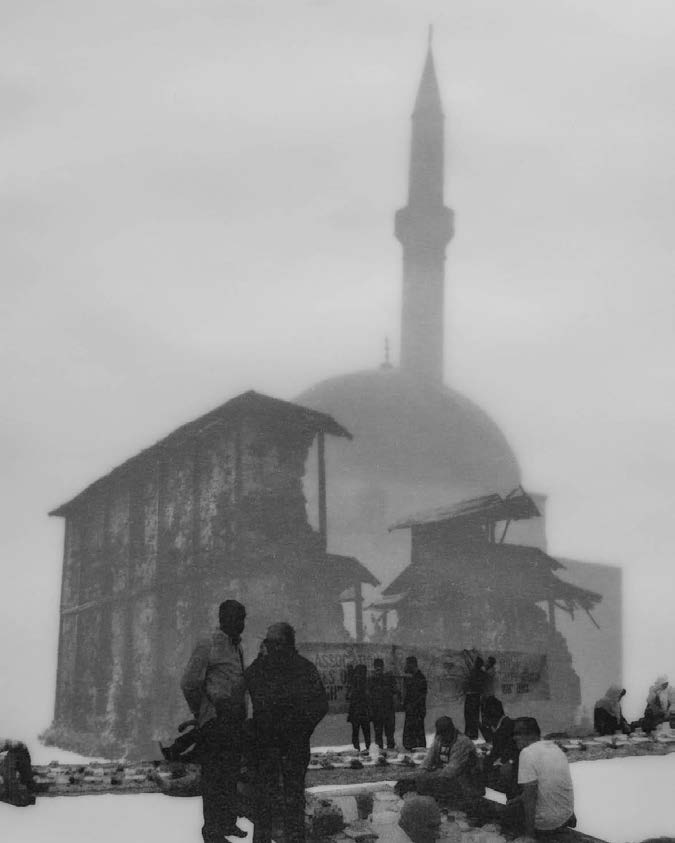
Layered collage on vellum of the Mehmed Pasha Kukavica Mosque in Foča
Constructing the “Ineffable”:
Designing a Public Bathhouse to Awaken the Sublime through Water
Student: Shreetika Singh
Advisor(s): Stephen Fai
This project began with a feeling.
It began with the questioning of an indescribable, incommunicable, and profound experience evoked in an airport. Provoking the question of how architecture can transport oneself, to create a space that does not feel like it is not on earth, to experience transcendence.
In an attempt to explore “ineffable spaces”, this project ventures into the world of transcending architecture to bring scarce out-of-body moments into public spaces to celebrate moments of humanity within us and our environment. This thesis proposes a water intervention in the form of a public bathhouse in the city of Vancouver. Using the element of water to awaken the ineffable and transport individuals to a fourth dimension.
The design is approached through various mediums of art, a sensorial understanding of the site, and the influence of water. This project aims to take individuals on a journey where they leave calm, inspired, and with a sense of a “greater meaning”.
Further questioning how then does architecture address a more personal and intimate need for individuals? How can architecture create moments of compilation, curiosity, and exploration? How can it provide a feeling of security, inspiration, faith, and humanity to everyday life?
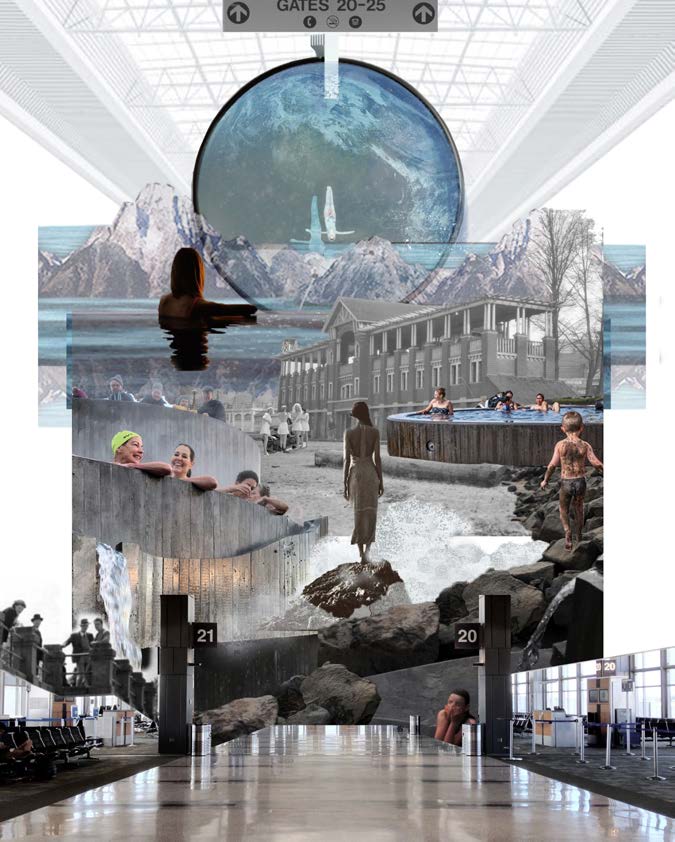
Abstract Collage illustrating the “Ineffable” through water.
From Non-Place to Place:
Transforming the Canadian Border through the Non-Human
Student: Travis Strochinski
Advisor(s): Piper Bernbaum
Borders have become political symbols that “celebrate” national identity by dividing the land and establishing an us versus them mentality. A non-place, that distinguishes one territory from the next. But as these lines physically exist in space, either through man-made infrastructures or geographical conditions, they no longer maintain this infinitely small dimension. Rather, a border exists in space as its own entity occupiable by someone or something.
While understanding that the border is used to control the human but cannot and does not control the non-human, my thesis will explore how ecological environments and animal migration can be used as a tool to breakdown the rigidity of the Canada/USA border. Furthermore, can infrastructures of care be introduced into these occupiable spaces to promote a place of inclusion rather than a line of division? These architectural interventions will be explored as a method of converting the invisible line from a non-place to a place, while also highlighting the legal fictions that exist along the border.
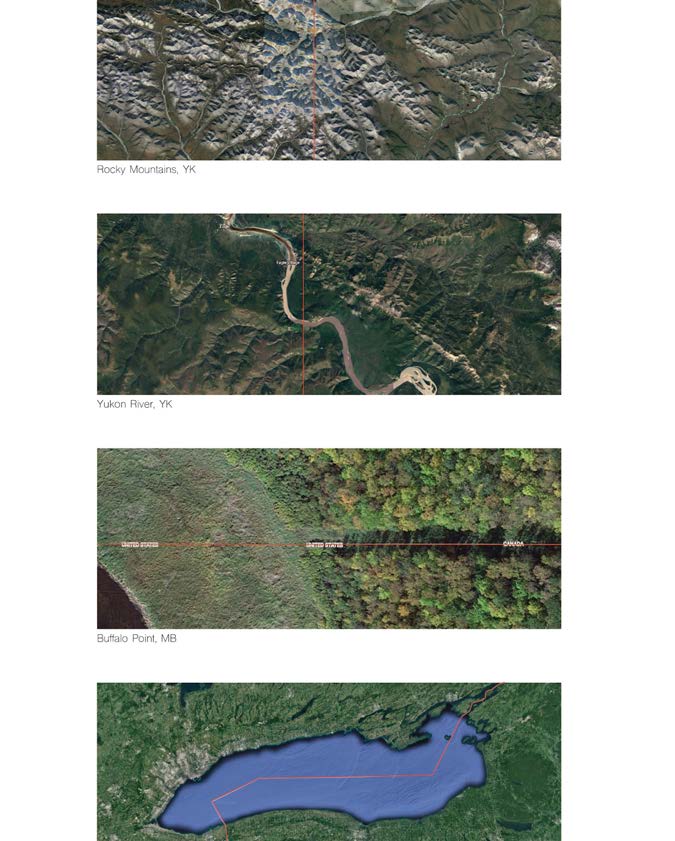
An Imposition of Political Control into the Natural Landscape
Engage-less
Student: Connor Tamborro
Advisor(s): Jerry Hacker
Today’s severe connection to the digital, the three W’s, or the coined term “hyper-connectivity” makes us more connected in specific ways, but in others, it is making us less connected. Our ability for critical engagement has sustained blurriness – with our environments, with ourselves, and with society in general. Instead, many of us engage in meaningless nominal interaction, often facilitated through the same type of media and connective devices that initially led to the problem.
We exist in a new era of fastness and sped-up time which on its own holds a greater capacity of thought for each human. Our unique position and experience in the world shape our personal lives and how we interact in them. Solitude and rest can extend this perception of time thus, it is in the world of built and unbuilt space that creates a moment of “slowness”.
This thesis explores a lamentation for the lost realms in which we willfully exist. Specifically, I am questioning how physical design can help re-discover stillness in an otherwise un-still world. Proposed devices of counter-resistance to the hyperconnectivity can reveal methods of slowness that suggests a re-imagination of modern nuances of architecture as a place of timelessness and authenticity of the human.

Visual representation of sustained blurriness in our conscious space.
Ecocentric Architecture:
A Counter-Proposal for Pierrefonds West
Student: Jillian Weinberger
Advisor(s): Lisa Moffitt
Habitat loss and fragmentation are the most significant factors causing species extinction. Humans are destroying animal habitats to suit their needs despite environmental conservation efforts to mitigate biodiversity loss. To preserve the natural environment as human populations grow and resources become scarcer, architects must conscientiously balance anthropogenic desires with environmental and ecological imperatives. I propose a perspective shift from anthropocentric design to ecocentric design, which prioritises designing for environmental concerns over human desires. The Pierrefonds West area in Montreal serves as both a case-study and a site. Through habitat drawings, ecological mappings, and theoretical reflection of existing ecological design frameworks, I will develop a counter-design proposal for the area. I will create an ecological design guidebook specific to Pierrefonds West for designing buildings, landscapes, and infrastructures that are thoughtfully and beautifully integrated into the local ecology. This illustrated guidebook will propose an architectural typology that reprioritises wildlife, habitat construction, and cohabitation between human and non-human species.

Layered map of Pierrefonds West’s environmental characteristics and anthropogenic presence
The Boundaries & Identity of Chinatown:
Treading In-Between the Gates to Where I Once Called Home
Student: Jamie Wong
Advisor(s): Suzanne Harris-Brandts
In major urban cities, property ownership is a powerful tool dictating who and what gets to belong. As land for development becomes scarce in the rapid evolution of cities, the world over, existing communities are being forced out through gentrification. This thesis draws on Toronto’s Chinatown West as a specific site of high contestation, exploring the politico-economic forces that influence its shifting boundaries and sense of collective identity. Through historical document analysis, photographing of site conditions, community member interviews, and mapping of the built environment, the research highlights the urgency of preventing this district from losing its distinct spatial identity. Utilising architectural design as an agent of tactical transformation, the thesis then proposes an intervention inspired by traditional Chinese gates—interpreted as symbolic entities of passage between two realms, as mediatory spaces to create discussion, as socio-cultural linkages, and as thresholds of identity in Chinatown.

Visualization on the Image of Chinatown
The Tao within the Way of Nature
Student: Fang Xu
Advisor(s): Manuel Baez
In search of ways of conceiving and designing experiential atmospheric spaces. My journey takes root deeply in Taoism by pursuing a natural balance among elements, such as light, earth, and water.
The balance, however, exists only within oppositions. Like Taichi, a realization of oppositions that reside and define every substance in nature. The oppositions are constantly reciprocally pushing and pulling on each other, generating forces of bonding. As everything is run by these forces, ultimately revealing the way of nature.
Current studies of atmospheres have addressed and engaged the Taoist philosophy of the cycles between fullness and emptiness. One study, titled ocean gauge, has engaged the tides by offering an atmosphereic experience that serves as a memory device to record the cyclic patterns. The study aims to evoke and recall one’s memories by activating intimate, moving and resonant emotions through time related experiences at different scales, from the intimate experience of the hours of the day to the projected speculations of hundreds of years.

An ancient chinese scroll depicting a Taihu Shi, a scholar’s stone
Healing of the Trauma:
Using Birds Echo Human to Cherish Nature and Peace
Student: Vivian Zhang
Advisor(s): Paul Kariouk
This thesis studies the relationship between the bird habitats, the economy of human society and human activities, with a hope to improve this relationship through design and to increase society’s attention to wild birds. Previous research has mainly focused on bird habitats or human damage to their environments, or individual designs to enhance bird habitats. Few formal papers examine the links between bird habitats and changes in human production and life. This Thesis aims to explain ways that human activities can be better combined with the reproduction of birds in their habitats. With the economic transformations in China due to the third industrial revolution, many heavy-industries and labor-intensive industries are declining; factories, buildings and associated being facilities are gradually being abandoned. This thesis focuses on several abandoned sites whereas a result of the decommissioning of the sites, the natural ecology that was previously left in the area has improved, and the return of surface water has promoted the formation of ponds, mudflats, and wetlands. Natural succession is taking place in these Shanghai “artificial” environments. This thesis seeks to understand the potential role that abandoned urban sites can play in bird conservation. In this thesis, an ecological survey of birds will be conducted at three sites to analyze the relationship between bird diversity and the environment; this research will then guide the design of new architectural landscapes. With proper design and management, can highly urbanized environments become no less attractive to wild birds than a park in an urban area or even a mountain forest in a rural environment? Can the conservation and management of urban abandoned sites become a benefit for conservation and biodiversity?
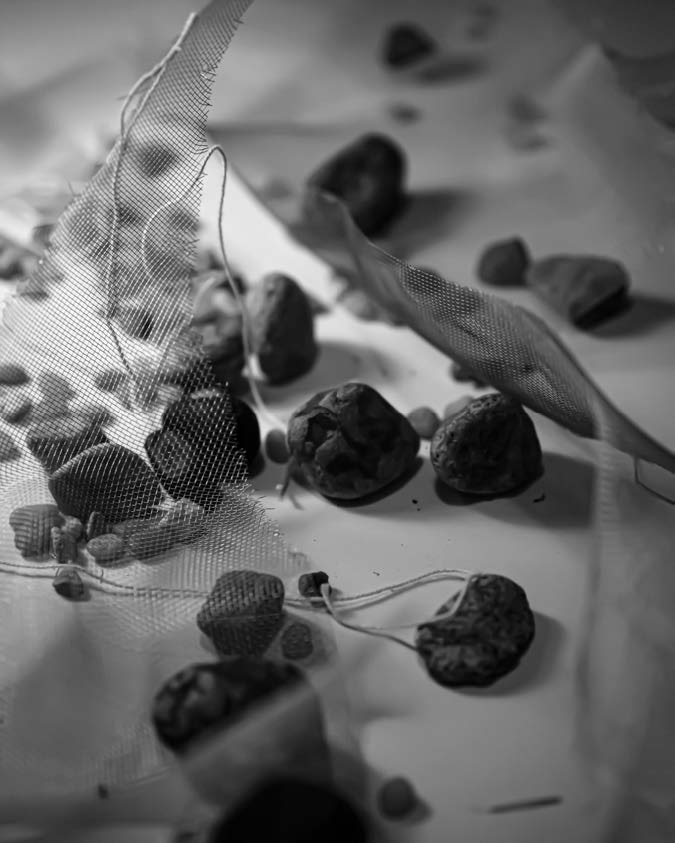
Photo of stone, mesh wire, and strings in progress of hand making models of bird’s nest
A Speculative Thesis with Provocative
Ideas of the Future
Student: Cameron Maiolo
Advisor(s): Johan Voordouw
This thesis aims to look at world-building and environmental story-telling of a speculative future inspired by the science fiction genre. While governed by catastrophic events fueled by climate change forcing our civilization as a whole to rapidly advance in a multitude of different ways. I have identified three regions with their own unique challenges. Through the three regions, I am developing visual imagery that captures the speculative world I am building and how it has responded. In addition, each image will carry with it a narrative story of a person living in the scene and a descriptive portion outlining the purpose of each major element of the scene. All three components together will help paint the picture of the future speculative world I am building.
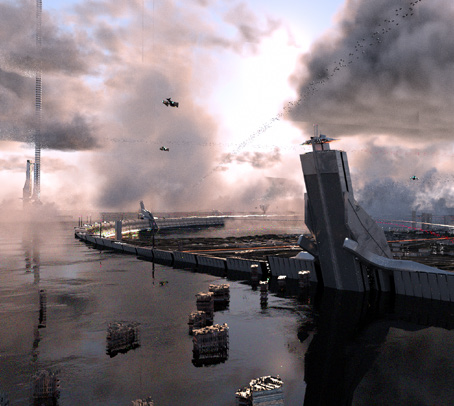
2212A — Panama Scene 0003 R23